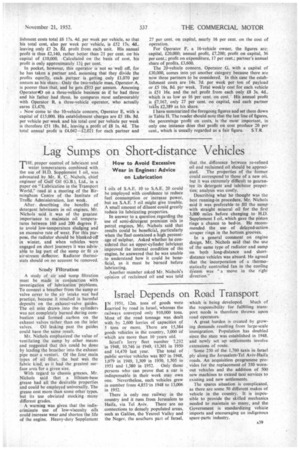Lag Sumps on Short-distance Vehicles
Page 57

If you've noticed an error in this article please click here to report it so we can fix it.
TIM proper control of lubricant and water temperatures combined with the use of H.D. Supplement I oil, was advocated by Mr. R. C. Nichols, chief engineer of Gulf Oil (G.B.), Ltd., in a paper on "Lubrication in the Transport World," read at a meeting of the Birmingham Centre of the Institute of Traffic Administration, last week.
After describing the benefits of detergent lubricants in oil engines, Mr. Nichols said it was of the greatest importance to maintain oil temperatures between 160 and 200 degrees F. to avoid low-temperature sludging and an excessive rate of wear. For this purpose, the radiator should be blanked-off in winter, and when vehicles were engaged on short journeys it was advis, able to lag part of the sump or fit an air-stream deflector. Radiator thermostats should on no account be removed.
Study Filtration A study of air and sump filtration must be made in conjunction with investigation of lubrication problems. To connect a breather from the sump or valve cover to the air intake was' bad practice, because it resulted in harmful deposits on the exhaust-valve guides. The oil mist drawn into the cylinders was not completely burned during combustion and formed .carbon on the exhaust valves rather than on the inlet
valves. Oil leaking past the guides could have the same result.
Mr. Nichols emphasized the value of ventilating the sump by other means and suggested that this could be done by lea. ding the breather into the exhaust pipe near a venturi. Of the four main types of oil filter, the best was the fabric kind, as it had the greatest surface area for a given sire.
With regard to chassis greases, Mr. Nichols said that a lithium-base grease had all the desirable properties and could be employed universally. The grease cost more than some other types, but its use obviated stocking many different grades.
A warning was given that the indiscriminate use of low-viscosity oils could increase wear .and shorten the life of the engine. Heavy-duty Supplement
I oils of S.A.E. 10 to S.A.E. 20 could be -employed with confidence to reduce fuel consumption or increase power, but an S.A.E. 5 oil might give trouble. A small amount of diluent could greatly reduce its lubricating properties.
In answer to a question regarding the use of semi-detergent premium oils in petrol engines, Mr. Nichols said that results could be beneficial, particularly when the fuel contained a high percentage of sulphur. Asked whether he considered that an upper-cylinder lubricant improved the internal condition of the -engine, he answered that he was unable to understand how it could be beneficial, as it must be binned before lubricating. Another member asked Mr. Nichols's opinion of reclaimed oil and was told that the difference between re-refined oil and reclaimed oil should be appreci ated. The properties of the former could correspond to those of a new oil, but it was extremely difficult to guarantee its detergent and inhibitor properties; analysis was costly.
Describing what he thought was the best running-in procedure. Mr. Nichols said it was preferable to .fill the sump with straight mineral oil for the first 3,000 miles before changing to H.D. Supplement I oil, which gave the piston rings a chance to bed-in. He recommended the use of delayed-action scraper rings in the bottom grooves.
In a general comment on engine design, Mr. Nichols said that the use of the same type of radiator and sump on both long-distance and shortdistance vehicles was absurd. He agreed • that the incorporation of a thermostatically controlled fan in the cooling iistem was "a move in the right direction."




















































































